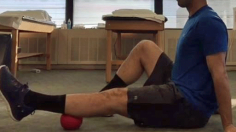
With winter finally over and spring in full swing, thousands of Washington DC-area runners will be dusting off their running shoes this month and hitting the trails. Running is one of the most popular forms of exercise in the United States and, according to the racing organization Running USA, its popularity continues to grow at an exponential rate. In particular, there has been a large uptick in the number of competitors completing organized road races across all distances, from 5K all the way up to marathons.1 This increase in popularity also means an inevitable increase in running-related injuries.
Common Running Injuries
Running, like all sports, has inherent risks. Research has shown that between 70 and 90% of recreational runners training for an event will sustain a musculoskeletal injury over the course of a 12-month period.2 These rates tend to be highest among novice runners and those training for longer distances (half marathon or more). The most common running injuries are patellar tendinopathy, medial tibial stress syndrome (shin splints), ankle sprains, hamstring strains, and Achilles tendinopathy.3
Why do running injuries happen?
The vast majority of running injuries are overuse injuries.4 Overuse injuries occur when the musculoskeletal system is exposed to a high volume of repetitive forces. Individually, these forces are below the threshold for injury but over time the cumulative effect of these forces causes inflammatory and degenerative changes in musculoskeletal tissues, resulting in pain and dysfunction.
There are three commonly recognized categories of risk factors for overuse injuries: training, anatomical, and biomechanical. Training risk factors include excessive mileage, inadequate rest, and poor nutrition and recovery. Some anatomical risk factors are arch height, leg length, and gender-related differences, such as hip width, body composition, and hormonal levels. Biomechanical risk factors are things like flexibility, dynamic balance, and strength. Training risk factors are best addressed with a running coach and dietician. Most anatomical risk factors cannot be modified or can only be influenced slightly. Therefore, the following will offer suggestions to improve biomechanical risk factors, specifically stretching, strengthening, and neuromuscular control exercises for runners.
Do more than just run
Runners are notorious for neglecting their flexibility and cross training. Some take running for granted rather than treating it as a skill; some mistakenly assume that running itself makes their legs strong and flexible; and some just don’t have time to do anything more than their training runs. It is important to include other forms of exercise in your routine to help support your body’s ability to run.
Listed below are some basic exercises that don’t take much time to do but can help to make you a stronger, more resilient runner. This list is hardly exhaustive but it’s a great place to start if you don’t already have a routine. No injury is completely preventable but by adding targeted stretching, strengthening, and neuromuscular exercises to their training, runners can address and improve risk factors that contribute to injury.
Flexibility
Perform 1–2 minutes of myofascial release for each of these areas 1–2 times/day and as a warm-up before runs.
- Myofascial release for plantar fascia, calf, and quadriceps—Using a ball or foam roller, massage the bottom of your foot, back of your calf, and front of your thigh for 1–2 minutes each to promote blood flow and decrease muscle stiffness.
Strength
Perform 3 sets of 15 reps, resting 1 minute between sets 2–3 times per week; never on back-to-back days and never before a run.
- Clam shell—Lie on your side with your knees bent, hips stacked, and feet together. Lift the top knee without moving your pelvis or feet.
- Reverse clam shell—Same start position as the clam shell. Lift the top foot without moving the pelvis or knee.
- Bridge—Lie on your back with knees bent. Brace your abs, squeeze your glutes, and lift your hips off the ground. Hold for a moment and then lower back down.
- Tennis ball raise—Gently squeeze a tennis ball between your heels and lift up onto your toes. Maintain pressure on the tennis ball throughout the movement.
Neuromuscular control
Perform as part of strength routine or use as part of an active warm-up before runs.
- Split squat—Assume a lunge stance and squat straight up and down. Do not shift your weight forward and backward as you would in a lunge; instead, drop your back knee and hips straight down. Go as low as you can control without your front knee caving in towards the midline of your body.
- Step down with ABD—Stand on a small block, 4–6”, and squat down using one leg. At the bottom of the squat, reach out to the side with the opposite leg. Keep your hips level and don’t let your stance knee cave in to the middle.
- “Y” balance drill—Stand on one foot and reach back and across your body with the opposite foot. Reach as far as you can control and then stand back up without putting any weight through the “reaching” leg.
Want to know more?
For more information about preventing or treating running-related injuries, email us or request an appointment. Be sure to follow us on Facebook and Twitter as well!
 Kevin McGuinness is a physical therapist at the SMARTherapy Center at Washington Orthopaedic & Sports Medicine and is a Certified Strength and Conditioning Specialist. He received his Doctor of Physical Therapy degree from George Washington University in 2013 and works with a wide range of patient populations, including high school, college, and professional athletes, as well as patients with spinal cord and traumatic brain injuries.
Kevin McGuinness is a physical therapist at the SMARTherapy Center at Washington Orthopaedic & Sports Medicine and is a Certified Strength and Conditioning Specialist. He received his Doctor of Physical Therapy degree from George Washington University in 2013 and works with a wide range of patient populations, including high school, college, and professional athletes, as well as patients with spinal cord and traumatic brain injuries.
References:
- “Statistics | Running USA.” Statistics | Running USA. 2016. Web
- Ellapen, T.J., Satyendra, S., Morris, J., & Van Heerden, H.J. (2013). Common running
musculoskeletal injuries among recreational half-marathon runners in KwaZulu-Natal. South African Journal of Sports Medicine - Lopes AD, Hespanhol LC, Yeung SS, et al. What are the main running-related musculoskeletal injuries? A systematic review. Sports Med 2012; 42:891–905.
- Hreljac, Alan, Robert N. Marshall, and Patria A. Hume. “Evaluation of Lower Extremity Overuse Injury Potential in Runners.” Medicine & Science in Sports & Exercise (2000): 1635-641.
